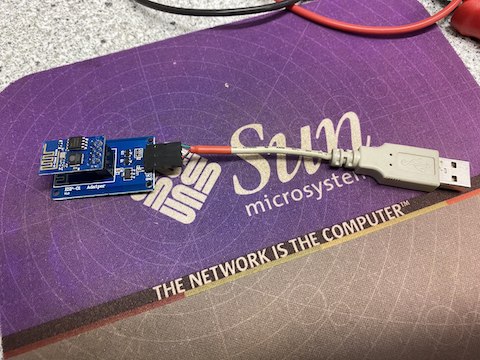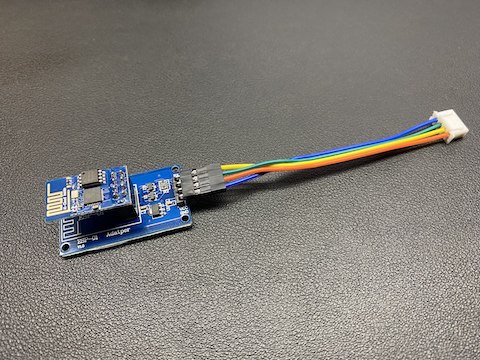esphome-midea-ac
Monitoring and controlling Midea-like air conditioners
Features
- Instant feedback of command changes via RF Remote to HomeAssistant.
- Direct control without the remote.
Supported Microcontrollers
This library should work on most ESP8266 or ESP32 platforms. It has been tested with the following MCUs:
- Generic ESP-12S board (ESP8266)
Usage
Step 1: Build a control circuit.
The signal levels are TTL 5V which means a level shifter is required when using the ESP-01 to convert the signals from 5V to 3.3V and vice versa. Also a voltage regulator is required if you want to power the ESP-01 from the 5V of the UART port.
Some AC units provide a JST-XH male connector to connect the WiFi SmartKey others provide a Type-A USB female connector (often connected to a JST-XH male connector) to connect the WiFi SmartKey. So you either need a Type-A USB male connector or JST-XH female connector to connect the ESP-01.
The drawing and table show which pins need to be connected.
| ESP-01 adapter | USB | JST-XH |
|---|---|---|
| Gnd | 4 | 4 |
| Vcc | 1 | 1 |
| Rx | 2 | 2 |
| Tx | 3 | 3 |
Step 2: Clone this repository into your ESPHome configuration directory
This repository needs to live in your ESPHome configuration directory, as it doesn't work correctly when used as a Platform.IO library, and there doesn't seem to be an analog for that functionality for ESPHome code.
On Hass.IO, you'll want to do something like:
- Change directories to your esphome configuration directory.
cd config/esphomegit clone https://github.com/uncle-yura/esphome-midea-ac.git
Step 3: Configure your ESPHome device with YAML
Create an ESPHome YAML configuration with the following sections:
esphome: includes: [esphome-midea-ac]- ESP8266 only:
logger: baud_rate: 0- disable serial port logging on the sole ESP8266 hardware UART switch: - switch component for manual control and feedbacksensor: - temperature sensor component for automatic controlclimate: - climate component for setting the automatic operation of the air conditioner
All climate control actions are as follows:
- homeassistant.service:
service: esphome.esp_conditioner_state
data:
speed: "10" # fan speed (0-100)
mode: "-1" # mode in (auto=1,cool=2,dry=3,heat=4,fan=5)
power: "-1" # power control (off=0,on=1)
vswing: "-1" # vertical swing activation (off=0,on=1)
hswing: "-1" # horizontal swing activation (off=0,on=1)
temp: "-1" # temperature setpoint (17-30)If you write "-1" in the parameter, it means that the parameter does not change.
The temperature sensor and the switch component are written to the lambda function:
custom_component:
- lambda: |-
auto midea_climate = new Midea(id(uart_bus),id(temperature_sensor),id(power_switch));
return {midea_climate};Example configuration
Below is an example configuration which will include wireless strength
indicators and permit over the air updates. You'll need to create a
secrets.yaml file inside of your esphome directory with entries for the
various items prefixed with !secret.
esphome:
name: esp_conditioner
platform: ESP8266
board: esp12e
includes:
- esphome-midea-ac
wifi:
ssid: !secret wifi_secret_ssid
password: !secret wifi_secret_password
# Enable fallback hotspot (captive portal) in case wifi connection fails
ap:
ssid: "Midea Fallback Hotspot"
password: !secret wifi_secret_fallback_password
captive_portal:
# Enable logging
logger:
baud_rate: 0
# Enable Home Assistant API
api:
password: !secret hass_api_password
ota:
password: !secret hass_ota_password
uart:
id: uart_bus
tx_pin: GPIO1
rx_pin: GPIO3
baud_rate: 9600
sensor:
- platform: template
id: temperature_sensor
climate:
- platform: thermostat
name: "Thermostat Climate Controller"
sensor: temperature_sensor
default_target_temperature_low: 20 °C
default_target_temperature_high: 25 °C
fan_mode_low_action:
- homeassistant.service:
service: esphome.esp_conditioner_state
data:
speed: "10"
mode: "-1"
power: "-1"
vswing: "-1"
hswing: "-1"
temp: "-1"
fan_mode_medium_action:
- homeassistant.service:
service: esphome.esp_conditioner_state
data:
speed: "25"
mode: "-1"
power: "-1"
vswing: "-1"
hswing: "-1"
temp: "-1"
fan_mode_high_action:
- homeassistant.service:
service: esphome.esp_conditioner_state
data:
speed: "100"
mode: "-1"
power: "-1"
vswing: "-1"
hswing: "-1"
temp: "-1"
fan_mode_middle_action:
- homeassistant.service:
service: esphome.esp_conditioner_state
data:
speed: "50"
mode: "-1"
power: "-1"
vswing: "-1"
hswing: "-1"
temp: "-1"
swing_vertical_action:
- homeassistant.service:
service: esphome.esp_conditioner_state
data:
vswing: "1"
mode: "-1"
power: "-1"
speed: "-1"
hswing: "-1"
temp: "-1"
swing_off_action:
- homeassistant.service:
service: esphome.esp_conditioner_state
data:
vswing: "0"
mode: "-1"
power: "-1"
speed: "-1"
hswing: "-1"
temp: "-1"
fan_only_action :
- homeassistant.service:
service: esphome.esp_conditioner_state
data:
mode: "5"
temp: "-1"
power: "1"
speed: "-1"
vswing: "-1"
hswing: "-1"
dry_action:
- homeassistant.service:
service: esphome.esp_conditioner_state
data:
mode: "3"
temp: "23"
power: "1"
speed: "-1"
vswing: "-1"
hswing: "-1"
cool_action:
- homeassistant.service:
service: esphome.esp_conditioner_state
data:
mode: "2"
temp: "17"
power: "1"
speed: "-1"
vswing: "-1"
hswing: "-1"
heat_action:
- homeassistant.service:
service: esphome.esp_conditioner_state
data:
mode: "4"
temp: "30"
power: "1"
speed: "-1"
vswing: "-1"
hswing: "-1"
idle_action:
- homeassistant.service:
service: esphome.esp_conditioner_state
data:
power: "0"
mode: "-1"
temp: "-1"
speed: "-1"
vswing: "-1"
hswing: "-1"
switch:
- platform: template
id: power_switch
name: "Conditioner Power Switch"
turn_on_action:
- homeassistant.service:
service: esphome.esp_conditioner_state
data:
power: "1"
mode: "1"
temp: "23"
speed: "102"
vswing: "0"
hswing: "0"
turn_off_action:
- homeassistant.service:
service: esphome.esp_conditioner_state
data:
power: "0"
mode: "-1"
temp: "-1"
speed: "-1"
vswing: "-1"
hswing: "-1"
custom_component:
- lambda: |-
auto midea_climate = new Midea(id(uart_bus),id(temperature_sensor),id(power_switch));
return {midea_climate};See Also
References and sources
The knowledge to create the logic to monitor and control the Midea-'like' AC units was gathered by reverse engineering Android applications from various vendors, analyzing the UART protocol between an Artel unit and an SK103 SmartKey, documents found on the Internet, primarily in Chinese and the work from:
- Mac Zhou: https://github.com/mac-zhou/midea-msmart
- NeoAcheron: https://github.com/NeoAcheron/midea-ac-py
- Rene Klootwijk: https://github.com/reneklootwijk/node-mideahvac
- Sören Beye: https://github.com/Hypfer/esp8266-midea-dehumidifier


